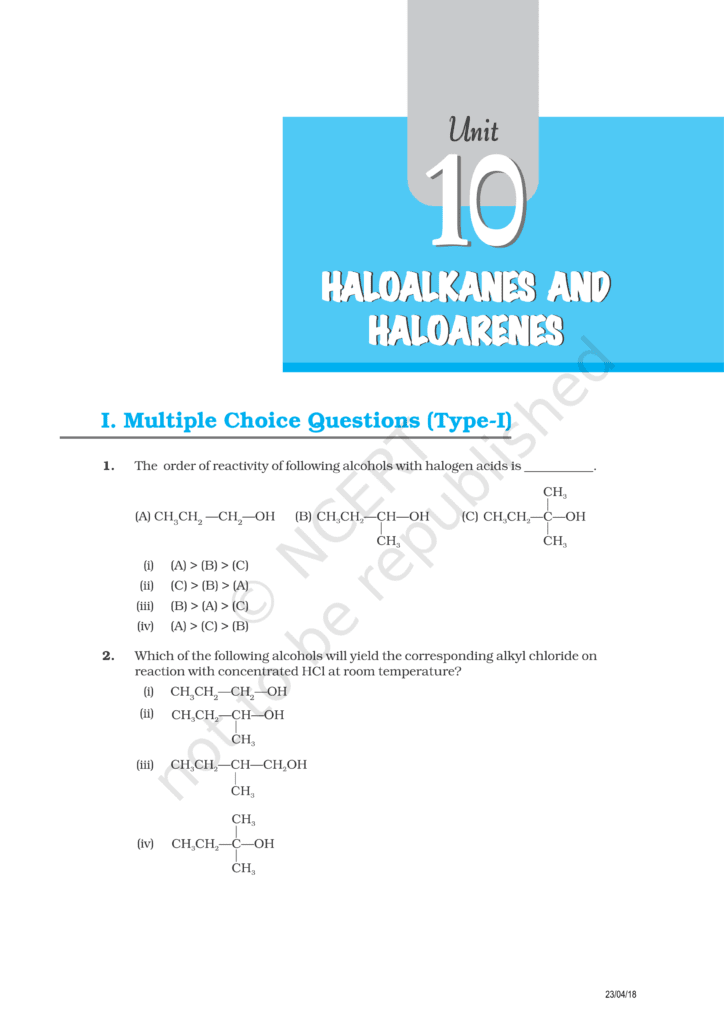Summary:Chapter 10 of Class 12 Chemistry focuses on Haloalkanes and Haloarenes, which are organic compounds containing halogens (fluorine, chlorine, bromine, iodine) attached to alkyl or aryl groups. The chapter explores the structure, nomenclature, physical and chemical properties, methods of preparation, and reactions of these compounds.

12 Chemistry Chapter 10 Haloalkanes and Haloarenes Book 📚📚 Download in PDF format 👇
The chapter begins with the classification of haloalkanes and haloarenes based on the type of carbon atom to which the halogen is attached. It then moves on to the IUPAC nomenclature of these compounds, where the position of the halogen atom is indicated by numbers in the carbon chain.
The physical properties such as boiling points, solubility, and density are discussed in relation to the size and electronegativity of the halogen atoms. The chapter also delves into the chemical properties of haloalkanes and haloarenes, focusing on nucleophilic substitution reactions (SN1 and SN2), elimination reactions, and reactions involving the halogen atom.
The preparation methods of haloalkanes and haloarenes are detailed, including the halogenation of alkanes, the addition of hydrogen halides to alkenes, and the Sandmeyer reaction. The chapter also covers the mechanism of these reactions, explaining how the nature of the substrate, the leaving group, and the reaction conditions affect the outcome.
The chapter concludes with the environmental and health impacts of haloalkanes and haloarenes, particularly concerning their role as pollutants and their effect on the ozone layer. The chapter also touches on the uses of these compounds in various industries.
Questions with Answers
1. What are haloalkanes?
Haloalkanes are organic compounds in which one or more hydrogen atoms in an alkane are replaced by halogen atoms (fluorine, chlorine, bromine, or iodine).
2. What are haloarenes?
Haloarenes are aromatic compounds in which one or more hydrogen atoms in an aromatic ring (such as benzene) are replaced by halogen atoms.
3. How are haloalkanes classified?
Haloalkanes are classified based on the type of carbon atom to which the halogen is attached: primary (1°), secondary (2°), or tertiary (3°) haloalkanes.
4. Explain the IUPAC nomenclature of haloalkanes.
In IUPAC nomenclature, the halogen atom is named as a prefix to the name of the alkane, with the position of the halogen indicated by the number of the carbon atom it is attached to. For example, CH₃CH₂Cl is named chloroethane.
5. What is a nucleophilic substitution reaction?
A nucleophilic substitution reaction is a chemical reaction in which a nucleophile replaces a leaving group (such as a halogen) attached to a carbon atom in an organic molecule.
6. Differentiate between SN1 and SN2 mechanisms.
The SN1 mechanism is a two-step process where the leaving group departs first, forming a carbocation, followed by nucleophilic attack. The SN2 mechanism is a one-step process where the nucleophile attacks the carbon atom simultaneously as the leaving group departs.
7. What is the role of a leaving group in nucleophilic substitution reactions?
A good leaving group is essential for nucleophilic substitution reactions as it determines the ease with which the halogen atom can be replaced. Halogens are generally good leaving groups due to their ability to stabilize the negative charge.
8. How does the nature of the substrate affect the SN1 and SN2 mechanisms?
The SN1 mechanism is favored by tertiary substrates due to the stability of the carbocation intermediate, while the SN2 mechanism is favored by primary substrates where steric hindrance is low.
9. What are the physical properties of haloalkanes?
Haloalkanes generally have higher boiling points than alkanes of similar molecular weight due to the presence of polar carbon-halogen bonds. Their solubility in water is low, but they are soluble in organic solvents.
10. Explain the term ‘elimination reaction’ in the context of haloalkanes.
An elimination reaction involves the removal of a hydrogen atom and a halogen atom from adjacent carbon atoms in a haloalkane, resulting in the formation of an alkene.
11. What is the Sandmeyer reaction?
The Sandmeyer reaction is a method for preparing haloarenes by reacting a diazonium salt with a halogen-containing reagent, typically CuX (where X is a halogen).
12. How does the presence of a halogen atom affect the reactivity of haloalkanes?
The presence of a halogen atom makes haloalkanes more reactive than alkanes due to the polar nature of the carbon-halogen bond, making the carbon atom susceptible to nucleophilic attack.
13. Describe the Wurtz reaction.
The Wurtz reaction involves the coupling of two alkyl halides in the presence of sodium metal in dry ether, resulting in the formation of a higher alkane.
14. What are the environmental impacts of haloalkane?
Haloalkanes, particularly chlorofluorocarbons (CFCs), are known to deplete the ozone layer, leading to increased UV radiation reaching the Earth’s surface.
15. Explain the term ‘aryl halides’.
Aryl halides are haloarenes in which the halogen atom is directly bonded to an aromatic ring, such as in chlorobenzene.
16. How are haloalkanes prepared from alcohols?
Haloalkanes can be prepared from alcohols by treating them with halogenating agents such as HX (where X is a halogen), PCl₃, or SOCl₂.
17. What is the Friedel-Crafts alkylation reaction?
The Friedel-Crafts alkylation reaction involves the introduction of an alkyl group into an aromatic ring using an alkyl halide in the presence of a Lewis acid catalyst like AlCl₃.
18. Why are aryl halides less reactive than alkyl halides in nucleophilic substitution reactions?
Aryl halides are less reactive due to the resonance stabilization of the carbon-halogen bond in the aromatic ring and the inability of the ring to stabilize a negative charge.
19. What is the mechanism of the Finkelstein reaction?
The Finkelstein reaction is a nucleophilic substitution reaction where an alkyl halide reacts with a sodium halide (usually NaI) to replace the halogen with iodine.
20. Explain the term ‘dehydrohalogenation’.
Dehydrohalogenation is a type of elimination reaction where a hydrogen atom and a halogen atom are removed from adjacent carbon atoms in a haloalkane, leading to the formation of an alkene.
21. What are polyhalogen compounds?
Polyhalogen compounds are organic molecules containing more than one halogen atom, such as chloroform (CHCl₃) or carbon tetrachloride (CCl₄).
22. How do haloalkanes participate in the synthesis of Grignard reagents?
Haloalkanes react with magnesium metal in dry ether to form Grignard reagents (RMgX), which are important intermediates in organic synthesis.
23. What is the effect of electronegativity of the halogen on the properties of haloalkanes?
The electronegativity of the halogen affects the polarity of the carbon-halogen bond, influencing the physical properties like boiling point and chemical reactivity of haloalkanes.
24. Describe the preparation of haloarenes from benzene.
Haloarenes can be prepared from benzene by halogenation, where benzene reacts with halogens in the presence of a Lewis acid catalyst like FeCl₃ or AlCl₃.
25. What are the applications of haloalkanes and haloarenes?
Haloalkanes and haloarenes are used in various applications, including as solvents, in pharmaceuticals, and as intermediates in organic synthesis.

Get involved!
Comments